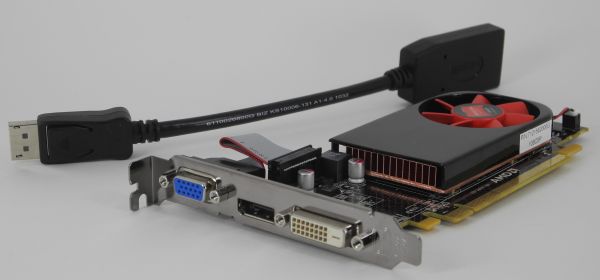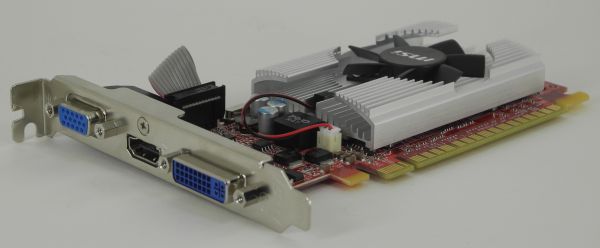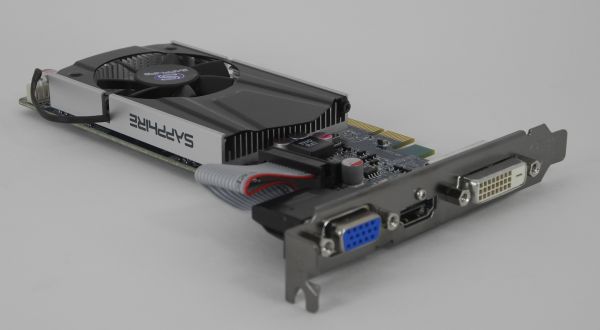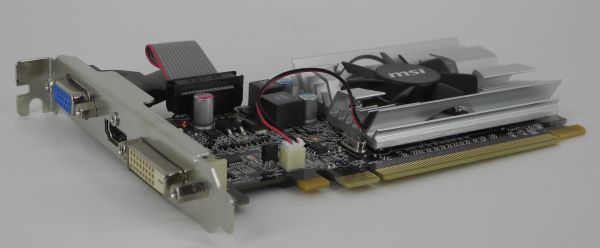Discrete HTPC GPU Shootout
by Ganesh T S on June 12, 2011 10:30 PM ESTOur first candidate has been in our labs for more than 6 months now. When we last took a look at the NVIDIA GT 430, it was an underwhelming performer. Have driver updates fixed the issues we had with the card? We are going to put the NVIDIA reference card through the paces and also through our new benchmarking methodology.
From the AMD side, we have 6450 reference card. This is the same card that Ryan took a look at earlier. We didn't cover too many HTPC specific issues in that review (except noting that the deinterlacing performance matched that of the 5570's), and we will correct that aspect in this piece.
AMD also provided us with a Display Port to HDMI adapter so that we could test out HD audio bitstreaming, and it worked without issues.
The second NVIDIA card we have in the list is the recently introduced GT 520. Ryan had again covered the launch, but without a detailed review. NVIDIA provided us with a retail sample of the MSI N520GT.
Rounding up our initial set of candidates is the AMD 6570 retail sample, courtesy Sapphire.
NVIDIA let us know that the GDDR5 based 6450 from AMD was not representative of what is available in the market. There is no passively cooled GDDR5 based 6450, and the core clocks of all the 6450s in the market weigh in at 625 MHz (compared to the reference card's 750 MHz). Keeping this in mind, we also added a DDR3 based MSI 6450 (quite late in the game) to the list of contenders.
The table below compares the listed specifications of all the contenders.
| Discrete HTPC GPUs Shootout Contenders | |||||
| NVIDIA GT 430 | AMD 6450 [GDDR5] | MSI GT 520 | Sapphire 6570 [DDR3] | MSI 6450 [DDR3] | |
| AMD Stream Processors | 160 | 480 | 160 | ||
| NVIDIA Stream Processors | 96 | 48 | |||
| Core Clock (MHz) | 700 | 750 | 810 | 650 | 625 |
| Shader Clock (MHz) | 1400 | 1620 | |||
| Memory Clock (Data Rate) (MHz) | 900 (1800) | 900 (3600) | 900 (1800) | 900 (1800) | 667 (1333) |
| DRAM Configuration | 128b 1GB DDR3 | 64b 512MB GDDR5 | 64b 1GB DDR3 | 128b 1GB DDR3 | 64b 1GB DDR3 |
| Max. TDP (W) | 49 | 27 | 29 | 44 | 20 |
Let us now proceed to take a look at the HTPC testbed in which these cards were benchmarked.















70 Comments
View All Comments
qwertymac93 - Monday, June 13, 2011 - link
What the heck are you talking about?velis - Monday, June 13, 2011 - link
A great review. Provides all the answers one could wish for and even gives some further hints.I sure hope you have something like this lined up for llano.
If I may suggest a couple or three things:
Perhaps you should also mention reclock - it will solve most 23.976 and similar problems... It's not like many will detect that the video is running 1/24000th faster. Plus it's insanely easy to use.
I understand you couldn't just post full blown images for space problems, but those thumbnails require too much work too. Is it possible to display a popup of sorts when one mouse-overs those thumbnails?
Also a vertical line showing 60FPS in those DXVA tests would be great :)
ganeshts - Tuesday, June 14, 2011 - link
I will pass on your request(s) to the person in charge of the graphing engine :)Salfalot - Monday, June 13, 2011 - link
What might have been a nice option is to see what sound levels the cards produced. Even it was only for the GT430 and the HD6570. I know that the decibels can differ between manufacturers but it would have been nice!For the rest a very nice detailed review between HTPC cards. I was deciding which card to buy so this helped a great deal! I was only looking between the HD6450 and the HD6570 but the GT430 is a better option than the HD6450.
nevcairiel - Monday, June 13, 2011 - link
HDMI Audio is purely digital, there is no diference based on what card you use.It depends on the audio decoder, and your receiver at the other end of the HDMI link, the HDMI sound card on those cards does not change the audio.
Salfalot - Monday, June 13, 2011 - link
I think I did not use the right word, as I meant the levels of decibel the fan of the cards produce and not the audio too and through speakers.All reviewed cards have a fan on them and since most of the HTPC setups are in the living room it would have been nice to know which of the cards are most silent.
ganeshts - Monday, June 13, 2011 - link
Though we considered cards with fans in this review, we made it a point to note that the same configuration (GPU model + DRAM bus width + operating frequencies) can be obtained with passive cooling from other vendors.For example, the 6570 has a passively cooled model from HIS with the same config and Zotac has a passively cooled 430 too. Other vendors have also demonstrated passively cooled models in Computex.
cjs150 - Monday, June 13, 2011 - link
Firstly, a truly informative article. Very high quality.The fact that none of AMD, Intel and Nvidia can lock onto to the correct frame rates is unforgiveable. It is not as though these frame rates have changed over the last 6 months. It should not be necessary to be an advanced HTPC user and delve into custom creation of frame rates.
I really hope that the representatives of AMD, Intel and NVidia are hanging their heads in shame at such basic errors - sadly I doubt they care.
Grasso789 - Monday, January 28, 2013 - link
The mistake is rather with Microsoft. Video playback speed should be adapted to the refresh rate of the grafx card. There is a software called Reclock doing that. Then, for example 23,996 Hz can be run with a monitor refresh rate of n times 24 Hz. (The same with audio, because bit-perfect transmission only works with synchronization.) In the end and for most sources, the RAMDAC needed only (multiples of) 24, 25 and 30 Hz. In any system, one of its parts should be the clock master, while the other parts serve.casteve - Monday, June 13, 2011 - link
Excellent review, Ganesh! Your HTPC insight/reviews have been missed.